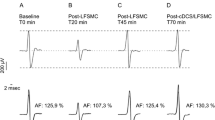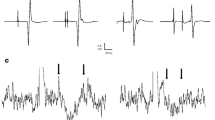Abstract
Electrical stimulation over the cerebellum is known to transiently suppress the contralateral motor cortex in humans. However, projections from the cerebellar nuclei to the primary motor cortex are disynaptic excitatory pathways through the ventral thalamus. In the present investigation we studied facilitatory effects on the motor cortical excitability elicited by electrical stimulation over the cerebellum by recording surface electromyographic (EMG) responses from the first dorsal interosseous (FDI) muscle in nine normal volunteers. For primary motor cortical activation magnetic stimuli were given over the contralateral hand motor area with a figure-of-eight shaped coil with a current to preferentially elicit I3-waves (test stimulus). For cerebellar stimulation high-voltage electric stimuli were given with an anode on the ipsilateral mastoid process and a cathode over the contralateral process as previously described (conditioning stimulus). The effect of conditioning-test interstimulus intervals was investigated. Anodal cerebellar stimuli increased the size of EMG responses to magnetic cortical stimulation at an interstimulus interval of 3 ms. Reversing the current of conditioning stimulus abolished the facilitation. The same (anodal) conditioning stimuli did not affect electrically evoked cortical responses. Based on the effective polarity of the conditioning stimulus and the time course of facilitation we consider that this effect is due to motor cortical facilitation elicited by activation of the excitatory dentatothalamocortical pathway at the deep cerebellar nuclei or superior cerebellar peduncle. We conclude that the motor cortical facilitation is evoked by cerebellar stimulation in humans




Similar content being viewed by others
References
Allen GI, Tsukahara N (1974) Cerebrocerebellar communication systems. Physiol Rev 54:957–1006
Amassian VE, Stewart M (2003) Motor cortical and other cortical interneuronal networks that generate very high frequency waves. Clin Neurophysiol 56 [Suppl]:119–142
Day BL, Thompson PD, Dick JP, Nakashima K, Marsden CD (1987) Different sites of action of electrical and magnetic stimulation of the human brain. Neurosci Lett 75:101–106
Day BL, Dressler D, Maertens de Noordhout A, Marsden CD, Nakashima K, Rothwell JC, Thompson PD (1989) Electric and magnetic stimulation of human motor cortex: surface EMG and single motor unit responses. J Physiol (Lond) 412:449–473
Di Lazzaro V, Molinari M, Restuccia D, Leggio MG, Nardone R, Fogli D, Tonali P (1994a) Cerebro-cerebellar interactions in man: neurophysiological studies in patients with focal cerebellar lesions. Electroencephalogr Clin Neurophysiol 93:27–34
Di Lazzaro V, Restuccia D, Molinari M, Leggio MG, Nardone R, Fogli D, Tonali P (1994b) Excitability of the motor cortex to magnetic stimulation in patients with cerebellar lesions. J Neurol Neurosurg Psychiatry 57:108–110
Di Lazzaro V, Restuccia D, Nardone R, Leggio MG, Oliviero A, Profice P, Tonali P, Molinari M (1995) Motor cortex changes in a patient with hemicerebellectomy. Electroencephalogr Clin Neurophysiol 97:259–263
Hanajima R, Ugawa Y, Terao Y, Sakai K, Furubayashi T, Machii K, Kanazawa I (1998) Paired-pulse magnetic stimulation of the motor cortex: difference among I waves. J Physiol (Lond) 509:607–618
Hanajima R, Ugawa Y, Machii K, Mochizuki H, Terao Y, Enomoto H, Furubayashi T, Shiio Y, Uesugi H, Kanazawa I (2001) Interhemispheric facilitation of the hand motor area in humans. J Physiol (Lond) 531:849–859
Holdefer RN, Miller LE, Chen LL, Houk JC (2000) Functional connectivity between cerebellum and primary motor cortex in the awake monkey. J Neurophysiol 84:585–590
Jörntell H, Ekerot C, Garwicz M, Luo XL (2000) Functional organization of climbing fibre projection to the cerebellar anterior lobe of the rat. J Physiol (Lond) 5222:297–309
Na J, Kakei S, Shinoda Y (1997) Cerebellar input to corticothalamic neurons in layers V and VI in the motor cortex. Neurosci Res 28:77–91
Pinto AD, Chen R (2001) Suppression of the motor cortex by magnetic stimulation of the cerebellum. Exp Brain Res 140:505–10 DOI 10.1007/s002210100862
Saito Y, Yokota T, Yuasa T (1995) Suppression of motor cortical excitability by magnetic stimulation of the cerebellum. Brain Res 694:200–206
Sakai K, Ugawa Y, Terao Y, Hanajima R, Furubayashi T, Kanazawa I (1997) Preferential activation of different I waves by transcranial magnetic stimulation with a figure-of-eight-shaped coil. Exp Brain Res 113:24–32
Sasaki K, Kawaguchi S, Oka H, Sakai M, Mizuno N (1976) Electrophysiological studies on the cerebellocerebral projections in monkeys. Exp Brain Res 24:495–507
Shinoda Y, Kakei S, Futami T, Wannier T (1993) Thalamocortical organization in the cerebello-thalamo-cortical system. Cereb Cortex 3:421–429
Steriade M (1995) Two channels in the cerebellothalamocortical system. J Comp Neurol 354:57–70
Ugawa Y, Day BL, Rothwell JC, Thompson PD, Merton PA, Marsden CD (1991a) Modulation of motor cortical excitability by electrical stimulation over the cerebellum in man. J Physiol (Lond) 441:57–72
Ugawa Y, Rothwell JC, Day BL, Thompson PD, Marsden CD (1991b) Percutaneous electrical stimulation of corticospinal pathways at the level of the pyramidal decussation in humans. Ann Neurol 29:418–427
Ugawa Y, Hanajima R, Kanazawa I (1993) Interhemispheric facilitation of the hand area of the human motor cortex. Neurosci Lett 160:153–155
Ugawa Y, Genba-Shimizu K, Rothwell JC, Iwata M, Kanazawa I (1994) Suppression of motor cortical excitability by electrical stimulation over the cerebellum in ataxia. Ann Neurol 36:90–96
Ugawa Y, Uesaka Y, Terao Y, Hanajima R, Kanazawa I (1995a) Magnetic stimulation over the cerebellum in humans. Ann Neurol 37:703–713
Ugawa Y, Terao Y, Nagai C, Nakamura K, Kanazawa I (1995b) Electrical stimulation of the cerebellum normally suppresses motor cortical excitability in a patient with ataxia due to a lesion of the middle cerebellar peduncle. Eur Neurol 35:243–244
Ugawa Y, Terao Y, Hanajima R, Sakai K, Furubayashi T, Machii K, Kanazawa I (1997) Magnetic stimulation over the cerebellum in patients with ataxia. Electroencephalogr Clin Neurophysiol 104:453–458
Werhahn KJ, Taylor J, Ridding M, Meyer BU, Rothwell JC (1996) Effect of transcranial magnetic stimulation over the cerebellum on the excitability of human motor cortex. Electroencephalogr Clin Neurophysiol 101:58–66
Acknowledgements
Part of this work was supported by Research Project Grant-in-Aid for Scientific Research No. 16500194 from the Ministry of Education, Science, Sports, and Culture of Japan, Grant-in-Aid for Research on new treatment of spinocerebellar degeneration, Ministry of Health, Labor, and Welfare of Japan. The Research Grant (15B-2) for Nervous and Mental Disorders from the Ministry of Health, Labor. and Welfare of Japan, a grant from the Committee of the Study of Human Exposure to E.M.F., Ministry of Public Management, Home Affairs, Post, and Telecommunications, grants from Life Science foundation of Japan and the Association of Radio-Industry and Business (ARIB).
Author information
Authors and Affiliations
Corresponding author
Rights and permissions
About this article
Cite this article
Iwata, N.K., Hanajima, R., Furubayashi, T. et al. Facilitatory effect on the motor cortex by electrical stimulation over the cerebellum in humans. Exp Brain Res 159, 418–424 (2004). https://doi.org/10.1007/s00221-004-1979-x
Received:
Accepted:
Published:
Issue Date:
DOI: https://doi.org/10.1007/s00221-004-1979-x




